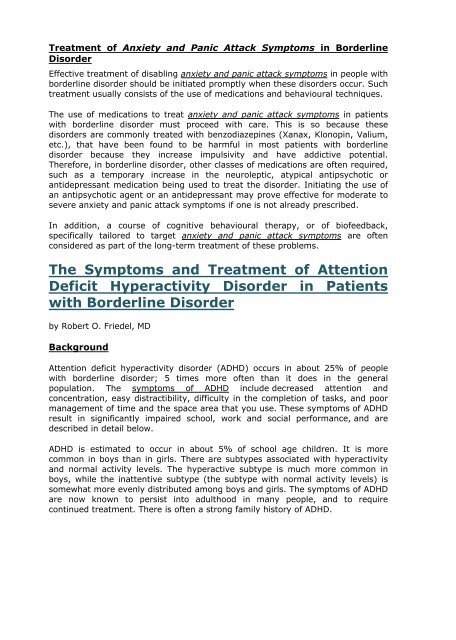personality disorders explained
Antisocial Personality Disorder, Codependence, Narcissism and Borderline
Antisocial Personality Disorder, Codependence, Narcissism and Borderline
Create successful ePaper yourself
Turn your PDF publications into a flip-book with our unique Google optimized e-Paper software.
Treatment of Anxiety and Panic Attack Symptoms in Borderline<br />
Disorder<br />
Effective treatment of disabling anxiety and panic attack symptoms in people with<br />
borderline disorder should be initiated promptly when these <strong>disorders</strong> occur. Such<br />
treatment usually consists of the use of medications and behavioural techniques.<br />
The use of medications to treat anxiety and panic attack symptoms in patients<br />
with borderline disorder must proceed with care. This is so because these<br />
<strong>disorders</strong> are commonly treated with benzodiazepines (Xanax, Klonopin, Valium,<br />
etc.), that have been found to be harmful in most patients with borderline<br />
disorder because they increase impulsivity and have addictive potential.<br />
Therefore, in borderline disorder, other classes of medications are often required,<br />
such as a temporary increase in the neuroleptic, atypical antipsychotic or<br />
antidepressant medication being used to treat the disorder. Initiating the use of<br />
an antipsychotic agent or an antidepressant may prove effective for moderate to<br />
severe anxiety and panic attack symptoms if one is not already prescribed.<br />
In addition, a course of cognitive behavioural therapy, or of biofeedback,<br />
specifically tailored to target anxiety and panic attack symptoms are often<br />
considered as part of the long-term treatment of these problems.<br />
The Symptoms and Treatment of Attention<br />
Deficit Hyperactivity Disorder in Patients<br />
with Borderline Disorder<br />
by Robert O. Friedel, MD<br />
Background<br />
Attention deficit hyperactivity disorder (ADHD) occurs in about 25% of people<br />
with borderline disorder; 5 times more often than it does in the general<br />
population. The symptoms of ADHD include decreased attention and<br />
concentration, easy distractibility, difficulty in the completion of tasks, and poor<br />
management of time and the space area that you use. These symptoms of ADHD<br />
result in significantly impaired school, work and social performance, and are<br />
described in detail below.<br />
ADHD is estimated to occur in about 5% of school age children. It is more<br />
common in boys than in girls. There are subtypes associated with hyperactivity<br />
and normal activity levels. The hyperactive subtype is much more common in<br />
boys, while the inattentive subtype (the subtype with normal activity levels) is<br />
somewhat more evenly distributed among boys and girls. The symptoms of ADHD<br />
are now known to persist into adulthood in many people, and to require<br />
continued treatment. There is often a strong family history of ADHD.

















